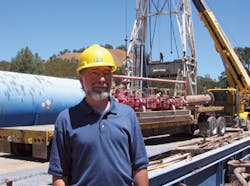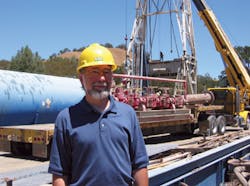USGS Examines Connection Between Earthquakes and Injection Wells
By Art Haddaway
Could an increase in the occurrence of earthquakes across the United States be the result of an ever-enlarging industrial footprint? According to a recent U.S. Geological Survey (USGS) report, it's a strong possibility.
The article "Injection-Induced Earthquakes," written by Bill Ellsworth, a USGS geophysicist, explains that there has been a significant increase in earthquake activity in unusual locations throughout the U.S. within the last several years. Moreover, a large amount of these tremors could be attributed to a surge in industrial activity, particularly oil and gas processes.
For the most part, earthquakes have naturally occurred predominantly in the western U.S. in states like California where movement of the Pacific and North American Plates regularly occurs along the San Andreas fault line. However, more quakes have arisen in the central and eastern parts of the U.S. in areas where "specific types of nearby industrial activities raise the possibility that these events were induced by human activity," said Ellsworth.
He explained that these man-made earthquakes may be triggered by pressure changes in faults occurring from operations such as the "impoundment of reservoirs, surface and underground mining, withdrawal of fluids and gas from the subsurface, and injection of fluids into underground formations." Throughout the earth's crust, there are already naturally-occurring stresses within these faults, and "if that pressure rise can communicate with a fault that is near its breaking point, an earthquake will be the result," he said. Ellsworth further described that hydraulic fracturing and wastewater injection of deep wells may be the source of the majority of these shocks.
As stated in the study, hydraulic fracturing contributes to a large number of earthquakes but has a relatively low risk of producing damaging tremors, whereas wastewater injection poses a higher risk.
Hydraulic fracturing is the practice of injecting high-pressure liquid below the earth's surface to create fractures in underground rock formations in order to extract natural gases. According to the research, this high-stressed pressure from the fracking process "intentionally induces numerous micro-earthquakes" but notes that they are too insignificant to be considered a harmful threat to property or the public.
States like Ohio, Pennsylvania, Oklahoma, and many others, as well as the province of British Columbia, are locations where "more than 100,000 wells have been subjected to fracking in recent years, and the largest induced earthquake was magnitude 3.6, which is too small to pose a serious risk," said Ellsworth. "Where we think most of the recent induced earthquakes have been occurring is in connection with wastewater disposal wells."
Unlike hydraulic fracturing, wastewater injection is done at lower pressures to permanently store the fluid deep underground. Because it operates at considerable depth and often with considerable volumes of fluid, the wastewater discarding process may exert significant stress within multiple subterranean levels that can potentially cause unavoidable disturbances. In fact, Ellsworth's article indicates that several of the biggest earthquakes occurring in the midcontinent between 2011 and 2012 may have been prompted by these types of wells, with the largest measuring at a magnitude of 5.6 in central Oklahoma that destroyed 14 homes and injured two people.
Also known as brine or "class II" wells, these sites are regulated by the Environmental Protection Agency (EPA) through the Underground Injection Control Program (UIC), which requires the injection of effluent to be as far below the earth's surface as possible to avoid the contamination of drinking water resources, further preserving overall water quality and public health. These federal statutes, however, do not monitor underground pore or injection pressures that are believed to lead to dangerous shifts within the surface.
"Wells with very high volumes of injection and deep into the sedimentary column can have somewhat of a higher potential for triggering earthquakes than operations that are perhaps better situated," said Ellsworth. "UIC class II wells (of which there are roughly 150,000 in the U.S., and about 30,000 of those are for wastewater disposal) are designed and regulated so that they don't cross-contaminate portable aquifers, and its consequences are quite deep; 5,000 to 10,000 feet is not unusual. It's these wells that have a clear correlation with the induced earthquakes."
Although a certain number of earthquakes that have occurred throughout specific parts of the country can potentially be linked to injection-induced processes, Ellsworth clarified that it's still difficult to distinguish between tremors that are natural and those that are man-made.
"Induced earthquakes sometimes occur at the source of the stress or pressure perturbation; at other times, these events take place deep below and kilometers away from the source," he said. "Sometimes induced events occur shortly after the industrial activity begins, but in other cases they happen long after it has been underway or even ceased."
Factors that contribute to the likelihood of pressure-induced earthquakes occurring, however, can include the magnitude of the stress or disturbance, its frequency and geographic reach, the conditions of local natural strain, and the presence of impaired faults in proximity to the stress field. Likewise, new developments in seismology have been underway in recent years to not only discern the causes of these earthquakes but to also recognize when and where they occur, as well as identify short-term and long-term predictabilities to help better manage them across the board. As Ellsworth illustrated, "methods for anticipating the time of failure have long been the ‘Holy Grail' of seismology."
One method of reducing the risk of these man-made earthquakes is what the industry calls "traffic light" systems, which involve setting guidelines that restrict or even suspend injection activity based on monitoring for earthquake activity; accordingly, it's a way to recognize if there are naturally-invoked tremors occurring alongside the injections, said Ellsworth.
"Are there ways of treating the waters so they can be disposed of without injection? Or reduce the volume of fluid that is being injected?" he asked. "Can we ensure that wells being used for injection are sited and monitored in a way that reduces the risk? This is why this ‘traffic light' system makes sense."
Other solutions Ellsworth proposed include the recycling of fluids for applications in the development of shale gas as well as the delegation of water for aquifer support or oil recovery in the production of petroleum. He also recommended that improvements be made in the way data of injection-induced sites is collected so that regulatory agencies could receive the necessary information to set appropriate standards for operation as well as provide more information on "hydrologic conditions potentially associated with induced seismicity."
"If we understood what the stresses were in the earth and we understood what the pressures were and we understood more about the hydrology, then we could do a pretty good job predicting whether a particular injection operation would have a higher or lower potential to induce earthquakes," Ellsworth said.
With the increase of earthquakes occurring in uncommon locations across the U.S. potentially induced by injection-based applications, water and wastewater professionals in the industrial sector are growing more aware of its effects and are starting to take the proper steps to prevent future incidents. "It's a manageable risk," he said, "and so the hope is that as we develop a better understanding, it will lead to perhaps the elimination of this particular risk."
About the Author

Art Haddaway
Assistant Editor
Art Haddaway is the Assistant Editor of WaterWorld and Industrial WaterWorld magazines. A writer and editor of over 10 years, he has contributed to a variety of regional publications covering everything from current events to creative features. Art is a graduate of Oral Roberts University in Tulsa, Okla., with a bachelor’s degree in print journalism.

